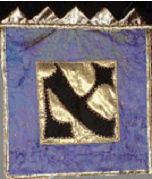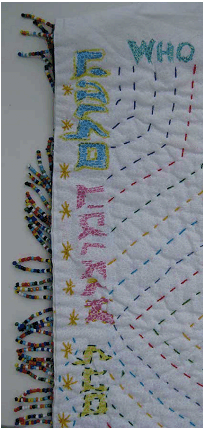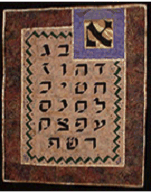
Learning Hebrew
So...Where can you find the Hebrew letters, words or names you need for your project? If you have a rabbi and/or cantor and/or Israeli friend who can write or print out what you need, that's a good option. Here are some more:
Use Hebrew Computer Fonts
Excellent Hebrew fonts are not expensive. For about $50, I bought the Davka Corporation's Hebrew Font Gallery. with thirty choices. (Click on Font set 1, 2, and 3 to see). Davka allows their fonts to be freely used in books, artwork, etc., without copyright issues.
To work with short Hebrew phrases or sentences, you do NOT need to buy 'Hebrew word processing software,' which tends to be much, much more expensive.
But here's the downside: With just the fonts (instead of a full word processing program), you will have to type the letters into line from the left to right, even though Hebrew words are spelled right to left. This can drive you NUTS until you get the hang of it.
Also, different fonts are not consistent about which key generates which Hebrew letter (An "A" may become an "aleph" in one font, and a "lamed" in another!) In fact, a punctuation mark on an English key can be a letter in the Hebrew font! )(I've spent hours looking for alephs hiding behind the remote uppercase ~ key). And Hebrew letters or symbols produced by lowercase keys can be different from upper case keys! It's all so unfair...
Despite all this, I've become pretty fast at typing the Hebrew needed. Here's how: I open a word processing or graphics program, and, in English, type out out every letter of the alphabet, every punctuation mark, every number, both in lower and uppercase (in the example at right, you see only the uppercase, before and after conversion.)
Once all the keys are typed out, I convert em all in one quick swoop to Judaism, er, the Hebrew font I want, below. That creates the full palette of Hebrew possibilities.
I then make a new box or sentence, and hunt, copy, and paste each letter that I need, one by one, to create the text I need (copying the spelling off my Bible, my note from my cantor, or one of the handy websites above).
If you were to 'translate' it back to English, you'd get an interesting word - or non-word. To spell Shalom, for example, in FrankRuh Light (a font that came with my computer), one ends up using the English keys for ouka. ( isn't that a Greek liqueur?) But don't memorize ouka - with a different font, it might be an entirely different combination of letters and punctuation.
Print out and carefully proofread the finished version in Hebrew. Maybe even show it to your local rabbi. It's VERY VERY easy to make mistakes when you're typing backwards in a foreign language.
Now Get it Onto the Fabric
Once you have the phrase in the size (and maybe color - and you can even manipulate shape in a graphics program) - then comes the fun part. You can:
So...Where can you find the Hebrew letters, words or names you need for your project? If you have a rabbi and/or cantor and/or Israeli friend who can write or print out what you need, that's a good option. Here are some more:
- Learn to recognize the letters here and here.
- Search the Torah online at http://bible.ort.org/intro1.asp. Includes the Haftarot, summaries of each portion, and blessings.You can find the text in English, then see it in Hebrew. You can print out the text for your own personal use. However, this site forbids unauthorized reproduction and distribution - which I believe means you are not permitted to print their text directly onto your fabric and put it onto your quilt, regardless of the purpose of your quilt (whether you are selling it, or stuffing it in the bottom drawer). What you can do, presumably, is use their Bible as a guide, rewrite or retype the biblical quotations, choosing the size, font, etc. - just as you might do from a paper Bible.
- Buy a CD ROM Bible. I own the Davka Corporation's CD ROM Judaic Classics Library Bible ("The Complete Hebrew/English Bible on CD with powerful search program." (www.Davka.com). They do allow printing out sections without copyright restrictions.
- Check the Jewish Encyclopedia. The 12-volume Jewish Encyclopedia, first published in 1901, is now online. When you search a topic, you may find the Hebrew words and letters you need, in the text of the article, or in one of the associated illustrations.
- Try this handy Hebrew Baby Name finder!
- There are many, many more online sources of Hebrew learning halfway down my Learning page.
- If you have lovely handwriting (or at least the ability to control your handwriting into temporary loveliness), consider calligraphy on fabric. Here's a guide to the traditional scribal letterforms. What kind of pen, ink, and/or fabric paint should you use? Read the advice of Lisa Engelbrecht, a quilt artist who has written a book and a terrific article (in the Winter 2004 Quilting Arts) about fabric calligraphy. (It's not about Hebrew, but the same approaches work).
- If you own a computerized embroidery machine, you just need to buy the software that will allow it to stitch out Hebrew letters. Find vendors and sources about halfway down on my Resources page, here.
Use Hebrew Computer Fonts
- There are many to choose from, and the text can be resized as needed.
Excellent Hebrew fonts are not expensive. For about $50, I bought the Davka Corporation's Hebrew Font Gallery. with thirty choices. (Click on Font set 1, 2, and 3 to see). Davka allows their fonts to be freely used in books, artwork, etc., without copyright issues.
To work with short Hebrew phrases or sentences, you do NOT need to buy 'Hebrew word processing software,' which tends to be much, much more expensive.
But here's the downside: With just the fonts (instead of a full word processing program), you will have to type the letters into line from the left to right, even though Hebrew words are spelled right to left. This can drive you NUTS until you get the hang of it.
Also, different fonts are not consistent about which key generates which Hebrew letter (An "A" may become an "aleph" in one font, and a "lamed" in another!) In fact, a punctuation mark on an English key can be a letter in the Hebrew font! )(I've spent hours looking for alephs hiding behind the remote uppercase ~ key). And Hebrew letters or symbols produced by lowercase keys can be different from upper case keys! It's all so unfair...
Despite all this, I've become pretty fast at typing the Hebrew needed. Here's how: I open a word processing or graphics program, and, in English, type out out every letter of the alphabet, every punctuation mark, every number, both in lower and uppercase (in the example at right, you see only the uppercase, before and after conversion.)
Once all the keys are typed out, I convert em all in one quick swoop to Judaism, er, the Hebrew font I want, below. That creates the full palette of Hebrew possibilities.
I then make a new box or sentence, and hunt, copy, and paste each letter that I need, one by one, to create the text I need (copying the spelling off my Bible, my note from my cantor, or one of the handy websites above).
If you were to 'translate' it back to English, you'd get an interesting word - or non-word. To spell Shalom, for example, in FrankRuh Light (a font that came with my computer), one ends up using the English keys for ouka. ( isn't that a Greek liqueur?) But don't memorize ouka - with a different font, it might be an entirely different combination of letters and punctuation.
Print out and carefully proofread the finished version in Hebrew. Maybe even show it to your local rabbi. It's VERY VERY easy to make mistakes when you're typing backwards in a foreign language.
Now Get it Onto the Fabric
Once you have the phrase in the size (and maybe color - and you can even manipulate shape in a graphics program) - then comes the fun part. You can:
- Print the words directly onto the fabric of your choice using the same techniques (and maybe products) that print photos to fabric to insure they don't wash out. That's how I did the lettering for the matzoh cover on the right - I printed them directly onto pink fabric that went through my printer.
- Print the words onto regular copy paper (or a tearaway stabilizer that can go through a printer). Then pin the paper directly over the fabric. Sew along the letter outlines. (In the second example at right, I outlined the letters twice with a dark multicolored decorative thread). Tear away the paper. Fill in the letter outlines as desired, with thread, paint, or ink. (Here I filled the inside with gold zig-zag stitching.) If this ordeal doesn't inspire you to buy a computerized embroidery machine, nothing will.
- Print the words IN REVERSE onto paper (mirror image them first, in the 'print properties' menu.) Pin the paper to the WRONG side of the fabric. Load the bobbin with decorative thread, and from the reverse side, sew along the outline of the letters. You can then fill in, or not. (Find atarot I did this way on this page.)
- Make a stencil. Print the letters onto paper, and glue the paper onto cardstock. Cut paper and cardstock out together with an xacto knife. Stencil onto fabric with paint. (I did that here: )
More Ways to Put Letters on Fabric
Rubber stamps. Stamp Hebrew and English letters on fabric with permanent ink pad, or acrylic paint. Inexpensive craft paints(especially metallics) work well. Shop carefully for your Hebrew letter sets. Some sets lack vowels and final consonants. And of course there is a direct relationship between the beauty of the stamps, and of your final product! (The gorgeous Shabbat lettering used for the challah cover at right was designed by Israeli artist Shulamit Ron, who unfortuantely has discontinued her stamp line for now). Drawbacks to stamping: Very few choices of size or font. And rubber stamping can be messy; you must practice AND get lucky. Sources of Hebrew aleph-bet rubber stamps:
Rubber stamps. Stamp Hebrew and English letters on fabric with permanent ink pad, or acrylic paint. Inexpensive craft paints(especially metallics) work well. Shop carefully for your Hebrew letter sets. Some sets lack vowels and final consonants. And of course there is a direct relationship between the beauty of the stamps, and of your final product! (The gorgeous Shabbat lettering used for the challah cover at right was designed by Israeli artist Shulamit Ron, who unfortuantely has discontinued her stamp line for now). Drawbacks to stamping: Very few choices of size or font. And rubber stamping can be messy; you must practice AND get lucky. Sources of Hebrew aleph-bet rubber stamps:
- 1-800-Dreidel at 1-800-dreidelcrafts.com, often carries Jewish-themed rubber stamps, including an aleph bet set, though it's not always on their online catalogue (call them for details).
- Jewishsoftware.com
- The Stencil Company http://www.quiltingstencils.com/index.asp Thanks to Vicki Dempsey for the referral.
- Jewish Gifts Galore, at jewishgiftsgalore.com. Click on 'Stencils.' You choose the alphabet, font, size, and message you want, in Hebrew and/or English -- they cut it. Very reasonably priced. They also have laser paper cuts, that can easily be used as quilting design stencils (Click on 'Scrapbooking') Vicki D. told me about this place, too!
- The Learning Plant, at www.thelearningplant.com. Simple and fun plastic stencils, including several aleph bets.
- Judaica for Kids, at Judaiacaforkids.com, (click on 'Stamps and Stencils'). Brass templates, including one aleph-bet and several symbols and messages. Sales manager Wendy Weinstein Darrow promises if you mention Judaiquilt, they'll take 10% off your first order.

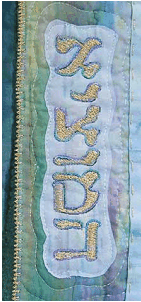
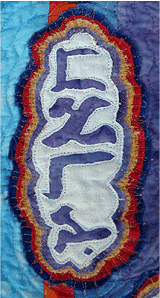
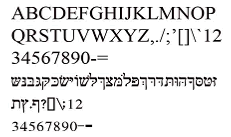
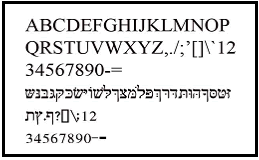

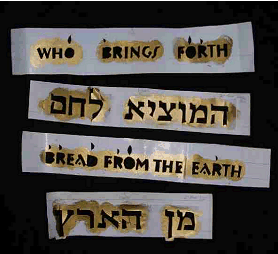
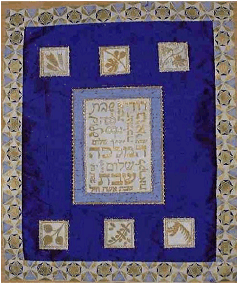
It's not surprising that the 'people of the book' would cover important textiles (as well as obscure websites) with verbiage.
Whether making an ark curtain, a challah or matzoh cover, a reader's desk cover, a tallit bag , a seder plate (right) - for centuries, Jewish artisans have added decorative reading material to the front. Nouns (Challah! Tallit! Matzoh!); proper names (David's tzitzit! Natan donated this Torah!) or entire prayers, captions, and lengthy explanations.
It's not only because we value literacy. The 22 Hebrew letterforms are extremely beautiful. The calligraphy of our sacred books is one of our most complex arts both in ancient times, and today (example 1 example 2.) The Kabbalists found a plethora of mystical meanings in each letter form - (and even in the numbers associated with each letter, depending on its place in the aleph-bet ).
Whether making an ark curtain, a challah or matzoh cover, a reader's desk cover, a tallit bag , a seder plate (right) - for centuries, Jewish artisans have added decorative reading material to the front. Nouns (Challah! Tallit! Matzoh!); proper names (David's tzitzit! Natan donated this Torah!) or entire prayers, captions, and lengthy explanations.
It's not only because we value literacy. The 22 Hebrew letterforms are extremely beautiful. The calligraphy of our sacred books is one of our most complex arts both in ancient times, and today (example 1 example 2.) The Kabbalists found a plethora of mystical meanings in each letter form - (and even in the numbers associated with each letter, depending on its place in the aleph-bet ).
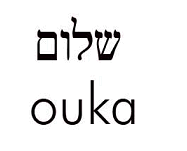
=
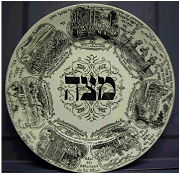
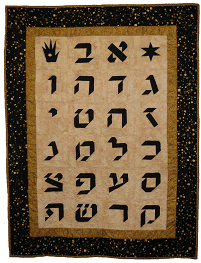
(Above and below) Calligraphy aleph bet. A pattern for this foundation-pieced quilt is available on the Patterns & Books page.
